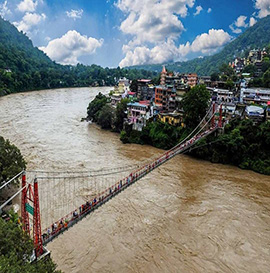My Rafting Camp destinations - Rishikesh
Rishikesh Gateway to the Garhwal Himalayas
In Ancient Language of World Sanskrit, Rishikesh is the name of Vishnu that means 'lord of the senses'. The place gets its name after Lord Vishnu who appeared to 'Raibhya Rishi', as a result of his tapasya (austerities), as Lord Hrishikesh. As per the Skanda Purana, Rishikesh Region also known as 'Kubjamrak' as Lord Vishnu appeared, under a mango tree. The name Rishikesh is loosely applied to an association of five distinct sections encompassing not only the town but also hamlets and settlements on both sides of the river Ganges..
Rishikesh, also spelt as Hrishikesh, is a city near Dehradun in Dehradun district of the Indian state Uttarakhand. It is situated on the right bank of the Ganges River and is a pilgrimage town for Hindus, with ancient sages and saints meditating here in search of higher knowledge. There are numerous temples and ashrams built along the banks of the river. It is known as the "Gateway to the Garhwal Himalayas" and "Yoga Capital of the World". The city has hosted the annual "International Yoga Festival" on the first week of March since 1999.
History of Rishikesh
Rishikesh was part of the legendary "Kedarkhand" mentioned in the Skanda Purana. Legends state that Lord Rama did penance here for killing Ravana, the asura king of Lanka. Lakshmana, Rama's younger brother, crossed the Ganges using two jute ropes at the point where the present Lakshman Jhula suspension bridge stands today. The 248-foot long iron-rope suspension bridge built in 1889 was washed away by flooding in 1924. In 1927, it was replaced by the current, stronger bridge built by the United Provinces Public Works Department, connecting the Tapovan, Tehri and Jonk, Pauri Garhwal districts. Another suspension bridge named Ram Jhula was built in 1986 at the nearby Sivananda Nagar. The Skanda Purana also mentions the site as "Indrakund" where Indra underwent a holy bath to remove a curse.


Rishikesh as Yoga Capital of World
Rishikesh was part of the legendary "Kedarkhand" mentioned in the Skanda Purana. Legends state that Lord Rama did penance here for killing Ravana, the asura king of Lanka. Lakshmana, Rama's younger brother, crossed the Ganges using two jute ropes at the point where the present Lakshman Jhula suspension bridge stands today. The 248-foot long iron-rope suspension bridge built in 1889 was washed away by flooding in 1924. In 1927, it was replaced by the current, stronger bridge built by the United Provinces Public Works Department, connecting the Tapovan, Tehri and Jonk, Pauri Garhwal districts. Another suspension bridge named Ram Jhula was built in 1986 at the nearby Sivananda Nagar. The Skanda Purana also mentions the site as "Indrakund" where Indra underwent a holy bath to remove a curse.
Rishikesh - Geography
Rishikesh is located at 30.103368. Rishikesh has an average elevation of 372 metres (1,745 feet).The Tehri Dam is just 80 km uphill on the way to Gangotri.Rishikesh is the starting point for traveling to the sites that form the Char Dham Pilgrimage - Badrinath, Kedarnath, Gangotri, Yamunotri.
Rishikesh Orientation
The best way to go around Rishikesh is on foot as the town is hilly and consists of narrow lanes. To cross the river take a motor ferry from the iron suspension bridge known as Ram Jhoola, which is near Swargashram, or walk across either Ram Jhoola or Lakshman Jhoola, 2 km upstream. Practised riders take two-wheelers over them, disturbing what is otherwise a tranquil walk. Noisy tempos (called Vikrams or phatpatis) are affordable contraptions with amiable owners who have arrangements, so you might find yourself disembarking and getting on again en route, depending on the driver's destination and the number of passengers left.
© 2023 Myraftingcamp.com All rights reserved.
